Frameworks Berlin, located in the heart of Kreuzberg, specializes in creating unique and original picture frames. Their custom frames are hand-made, one-of-a-kind pieces made from recycled wood. The team provides accessible and affordable options for artists, professionals, and art-lovers. The frames themselves can be deemed as decorative and inventive pieces of art. Using recycled materials, Frameworks Berlin is providing customers with sustainable products that come with a history as well as a high standard of preservation.
Berlin Art Link caught up with owner Claire D’Orsay and team to discuss how her business idea began, what they offer and where Frameworks Berlin is headed to next.
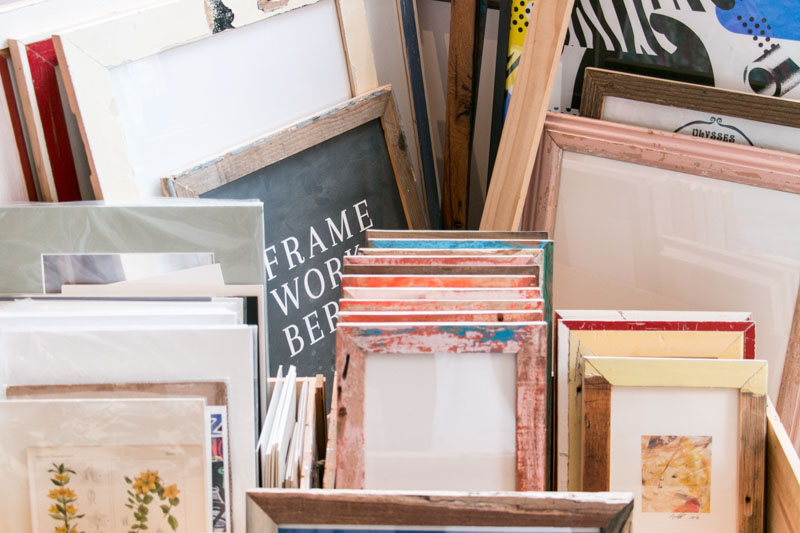
Photo by Sandra Camey
Lisa Birch: Can you briefly introduce yourself and tell us the story behind Frameworks Berlin?
Claire D’Orsay: I’m from New York and my partner is a Berliner. We came here 7 years ago when I was 25 and we have never left since. I have my masters degree in psychology and while I was studying in Boston, there was a picture framing store across the street. They had a DIY part to the store where I could go in, buy the material for cheap and build the picture frame myself. That’s really where it started. When I got here to Berlin, I realized that working as a psychologist was tremendously hard and I didn’t really want to do it. In Berlin there’s such a diverse art scene and I decided maybe I should go ahead with the whole picture framing idea. I started doing it on the side while working at the Brandenburg International School, but I knew even from the get-go in the DIY store that this was for me. I took a job and did my training with Stephan Landwehr, a framer here in Berlin. After three years there, I could see that the majority of stores all offered exactly the same types of frames. I realized that the only way I could come into this market competitively was to do something different. That’s where the idea of using recycled wood came from.
LB: Do you prefer the creative freedom that comes with Frameworks Berlin as opposed to creating traditional frames?
CD: Absolutely! When I started this project, I really looked into the history of picture framing. Frames in the past used to be part of the artwork themselves. In older paintings, the artists would actually carve into the wood and extend the design into the picture itself. This notion of modern black-and-white frames only began about 60-70 years ago. My non-art historical analysis concludes that when modern art simplified, the frame also had to simplify. These days we think of slick black and white frames as normal but actually if you look at the three thousand year history of framing, with the first examples of picture framing coming from Egypt, they were always exotic, decorative and a piece of art in their own right.
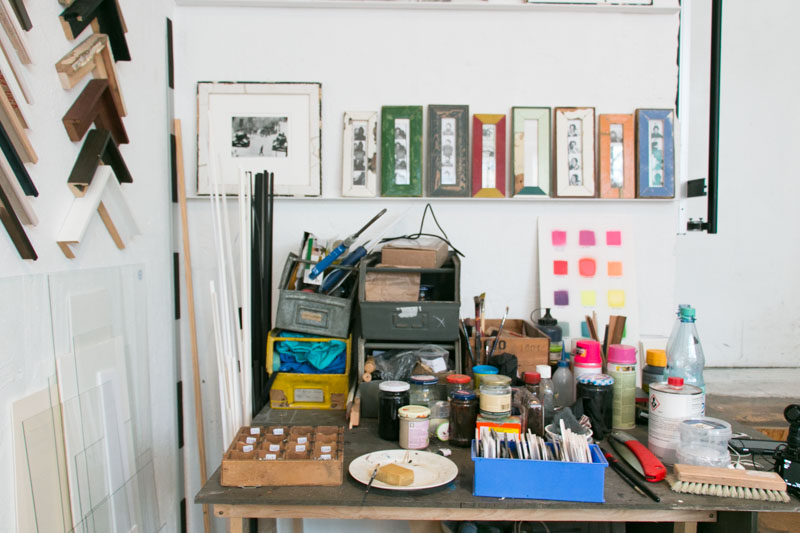
Photo by Sandra Camey
LB: That’s an interesting point. How do you consider the role of a frame together with an art piece? What should be expected of a frame?
CD: The frame’s first priority is to protect the art. People often don’t think of it in that way, but really it’s a technical job. I look at our framing in three different ways. The frame itself can essentially be the art, first you buy the frame and then you find something to go in it. In this case the artistic aspect is the frame. Another way is to find a balance between the frame and the art work: when the frame is more simple it balances out the art work. The last way is to get the simplest piece of recycled wood and focus on the art work. It depends on each piece really, who is it for and what is it for? When art has a frame it instantly looks better, it transforms the work. I don’t know if it becomes more professional, or more whole, or more finished, or what it is exactly, but it’s an important difference. Our frames are very noticeable but there’s more behind it than that, it’s about what framing does for art and what art does for framing. Framing makes people want to buy art because it’s a finished product. If a picture is presented on the wall without a frame, it doesn’t look as good as it does with one. That is hands down what framing does. Art and frames belong together.
LB: As well as making custom frameworks you also offer a rental deal to artists. How does the deal work?
CD: We have an offer for artists, which is kind of on the hush-hush. The offer is that if you are an artist who isn’t represented by a gallery, then we can potentially offer free frames for your show. If the artist sells the piece we get the full amount for the frame, and if not, they get free rental of framing. It’s our way of supporting the artist community in Berlin. We know art looks better in a frame but we also know that artists often can’t afford professional framing. Obviously, if we get flooded with artists it won’t always be possible for us to do, but we do what we can. We work on a first come first serve basis. Recently we have been working with a group called KUNST100, they run exhibitions here in Berlin. They came to us and asked if they could borrow frames and we said yes. Now we support them with their exhibitions. We would like to do more of that but, like I said, it’s limited.
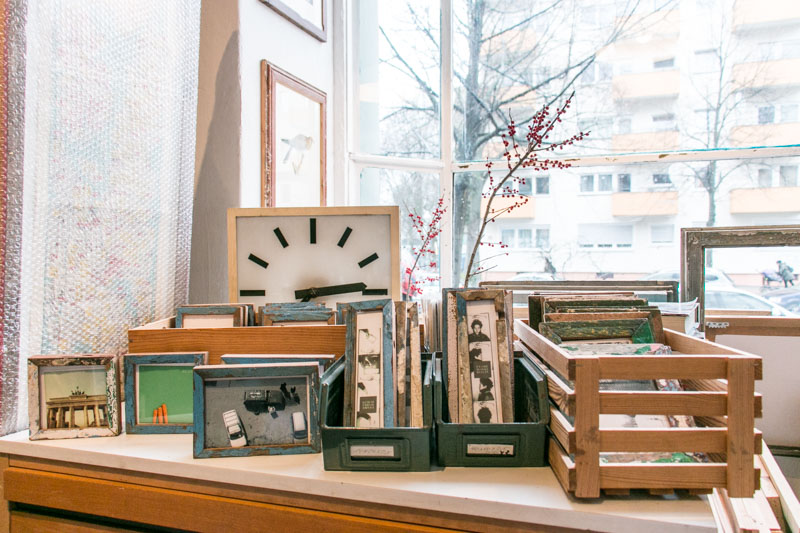
Photo by Sandra Camey
LB: Where do you source the material?
CD: All over Berlin. We have old doors, old tables, stuff we pick off the street and things we buy from collectors. We go into apartments that are being renovated, we drive around the city and find containers filled with doors. Seriously, it’s unbelievable! There is such incredible furniture in Berlin that people are throwing out and unfortunately renovation in Berlin means taking out something beautiful and putting in something cheap. This exchange means we currently have a lot of material, but one day it will all be gone.
LB: So the products are completely sustainable?
CD: Our products are one hundred percent upcycled. The reason our frames are a little more expensive than average is because our products are ninety percent work. It take hours to go out, find stuff, bring it back and remove all of the metal from the doors. It takes hours to take a door apart, it takes hours to make it into the actual piece of moulding. The sustainability part is that we are not making more garbage, and of course as a customer you are paying for that concept.
We only collect wood from Berlin, except our recent project in Bali where we are buying old boat wood. In Berlin, you have white, green, brown and natural wood. These are beautiful, of course, but we couldn’t get much of a diversity of colour, finding blue wood is a miracle in Berlin. I had a connection in Bali so I went there to check it out. In Bali, the fishing boats they use are very old. Every year they paint them a new colour, so then you have this incredible mix of black, blue, pink, everything. And you’ll never find that in Germany. This diversifies our wood selection dramatically in terms of colour, and that was the reason why we decided to source wood there. The other side of it is that we aren’t using a factory in Bali, we work with a carpenter and his neighbours. So, it’s straight-up local, it is not exploitative, the only downside is of course the transportation.
LB: What is the strangest thing that you have had to frame?
CD: We’ve framed spoons and all sorts of things but probably the strangest was when we framed a bug. This woman came from Malasia and she brought a humongous bug. We made a really classic African walnut frame and we pinned it into the backboard. I would say that’s the strangest thing: it was huge.
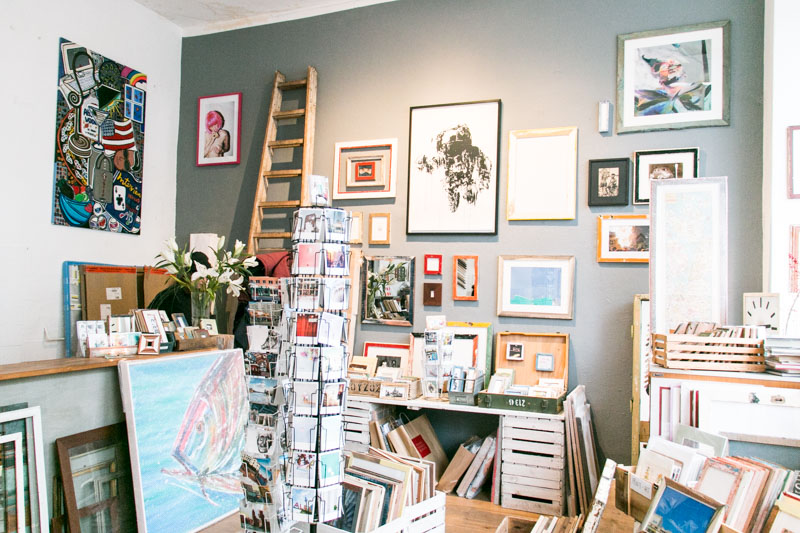
Photo by Sandra Camey
LB: Even though you have a very original idea, the concept of upcycling is becoming more popular, especially in places like Kreuzberg. Does Frameworks Berlin get swallowed up in the Berlin creative swamp?
CD: It definitely doesn’t get lost. I think if anything we benefit from it because people have a broader understanding of recycling and sustainability these days. There are other companies making things out of second-hand wood but as far as I know, we are the only place that offers professional picture framing. We know how to handle the artwork, preserve the artwork and work with clients. We give them a finished product not just a frame. That’s also why we offer our workshops, so that other people can make their own picture frame.
LB: You offer workshops every month where people can learn how to build their own frame. Would you consider opening up the workshop for public use on a more regular basis?
CD: That was the concept that originally inspired my idea. My original business plan was to open a picture framing shop with a DIY aspect but when I wrote the business plan I realized that, financially, it didn’t make sense. In general, artists want cheap, people want cheap, people think cheap is normal but actually cheap doesn’t get you a sustainable business. So that’s why I changed my plan to a traditional picture framing store. Offering workshops is, for me, the perfect balance between the two ideas of DIY framing and the shop itself. The workshops are my way of getting people in who want to learn how to frame for themselves. We can teach them the necessary skills and provide the tools and space to do so. At the moment we can’t offer it out for public use except the workshops, but it could be a possibility in the future.
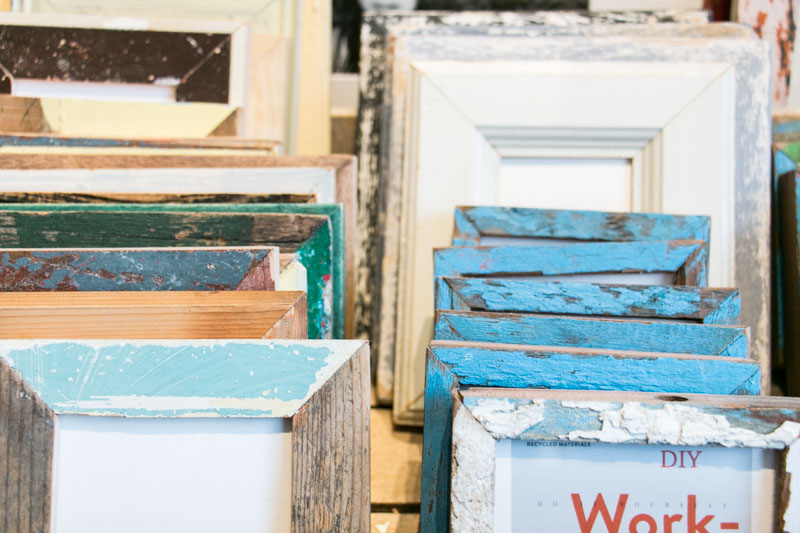
Photo by Sandra Camey
LB: I saw that you were on Radio 1 Berlin in January. Is Frameworks Berlin starting to become more recognised?
CD: That was actually my colleague Babs on the radio, that wasn’t me. But we definitely have our regular customers who are returning and tourists, who of course just stumble across the shop. The name Frameworks is definitely building and that makes me so proud. In the last year or so, many customers have heard of us through recommendation, and I want it to keep going. We are still a small business who needs to keep establishing itself. But we are learning from experience and definitely going from strength to strength.

























